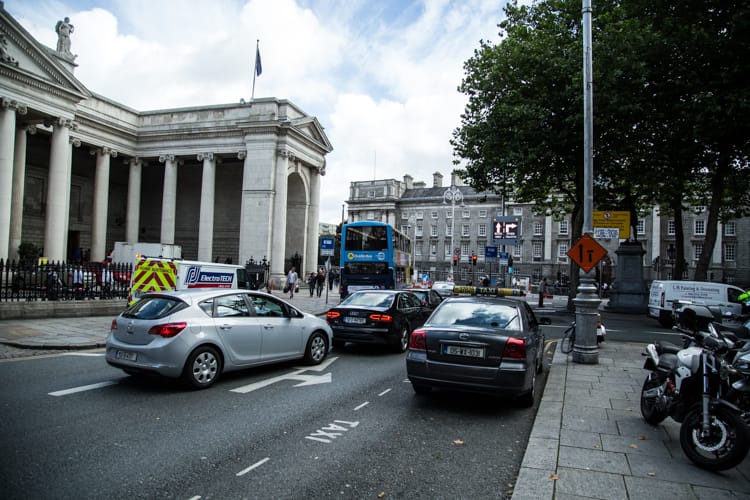What’s the best way to tell area residents about plans for a new asylum shelter nearby?
The government should tell communities directly about plans for new asylum shelters, some activists and politicians say.
Most of those opposed to making Dublin’s city centre nicer for pedestrians, cyclists and public-transport users are car-users who live out in the suburbs. Why should the city be designed for them?

You could bet your bottom dollar that nearly everyone opposing the Dublin city centre transport plan drives into town and has a guaranteed off-street parking space, free of charge, to store his (or her) company car for the day before driving home to the suburbs.
They don’t tend to cycle, and they walk as little as possible – usually a short distance between the car park and the office, or perhaps around the corner to some bistro or café. Thus, their perceptions of the city are largely derived from sitting behind the steering wheel of a car.
The Irish Parking Association, which represents the owners of multistorey car parks, has said that the plan to restrict car traffic “appears to ignore . . . the common sense fact that a car-borne customer of the city will not come in if they can’t park within a reasonable distance”.
This “reasonable distance” amounts to “no more than 300 to 400 metres” from their final destination, the association claimed, citing unnamed “parking and traffic experts”. As a result, it argued, the proposed restrictions could reduce retail and entertainment revenue by 24 percent.
The parking lobby commissioned a Red C survey of just over 1,000 shoppers in Grafton Street and Henry Street, which found that the car users accounted for 41 percent of retail revenue from “planned shoppers” in the city centre, spending an average of €134 per visit compared to €94 for bus and Luas users.

IPA President Keith Gavin told the Irish Times that the association “does not accept that making car access to the city centre more difficult will simply cause people to switch to other modes of transport”, and warned that they would travel elsewhere instead.
The big fear factor is that, if Dublin City Council and the National Transport Authority pursue their plans to close College Green to through traffic, and restrictions are also imposed on the Liffey quays, car-borne shoppers would desert the city centre in favour of Dundrum.
“Three in five city centre shoppers who used their car said they would not do so if the access restrictions proposed were in place and . . . 10 per cent of all shoppers would not have visited the city centre, according to the survey,” the Irish Times reported, rather gravely. [Editor’s note: See our article for why these figures are suspect.]
All of these findings were gleaned from what amounted to a vox pop survey of planned shoppers on two city-centre streets. Both the IPA and Red C were quite open about what questions were asked, how they were framed and what age groups were represented.
The parking lobby’s experts claim that car-borne shoppers won’t walk more than 300 to 400 metres between where they park and some department store or other attraction. Yet it’s regarded as quite normal for public-transport users to walk 500 metres to a bus stop or station.
Fifteen years ago, when then traffic supremo Owen Keegan (now DCC’s chief executive) introduced bus lanes on the Stillorgan Road, the motoring lobby went bananas, with the likes of the Automobile Association’s Conor Faughnan warning of chaos. But it all worked out fine in the end.
At issue here is a pathetic failure to imagine that positive change is possible. We used to think it was “normal” that nearly all of the State’s traded goods should be transported up and down the Liffey quays in juggernaut trucks. Then we built the Port Tunnel, and they vanished.
Nobody knows what would happen after the quays are choked for through traffic, or where all of the 70,000 vehicles per day currently using this artery would go. However, traffic tends to find its own level in any city, and there is no reason to believe that it won’t in Dublin.

Contrary to claims made by the parking lobby and Retail Ireland (a division of employers’ group IBEC), it is simply not possible to improve the lot of pedestrians, cyclists and public transport without taking road space away from cars and reallocating it to these other road users.
Proposals by opponents of the city centre transport plan for yet more studies and reports are simply a delaying tactic, to forestall its early implementation. These should be rejected by Dublin City Council and the National Transportation Authority, in view of the many, many expressions of support for what’s in the plan.
With preparatory work well under way on the Luas Cross City line, city planners should be devoting themselves to drawing up a master plan for the redevelopment of Broombridge – replacing its largely derelict box-like industrial units with a vibrant new residential community.
Cars have dominated Dublin for too long. We need to reclaim the streets.
Get our latest headlines in one of them, and recommendations for things to do in Dublin in the other.